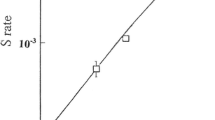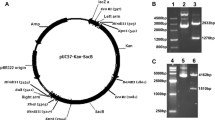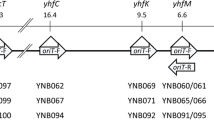Summary
The chromosome mobilization is the ability of F+ donors to introduce part of the chromosome besides F-plasmids into the recipient cells during conjugation. We studied the genetic determination of this phenomenon. Most efficient almost like true Hfr's are F+-cells of the genotype recBC - sbcB - belonging to the RecF-recombination type. Their ability to chromosome mobilization is 50 fold higher comparing with wild type F+ (of the RecBC-recombination type). This property is fully dependent on the recF gene but does not depend on recL. The donors recBC -F+ but without the mutation sbcB - act in mobilization about 4 times weaker than wild type. Hence we see two main levels of mobilization, quantitatively very different: a recF-dependent and recBC-dependent. Both reveal an absolute requirment of the product of recA gene.
The efficiency of mobilization of different markers along the chromosome was studied and mapped. The maps were identical, in spite of great difference in absolute frequencies for the RecF- and Rec BC-pathways. They are not at all random. The sites of mobilization are coinsident with the points of interaction of the F-factor leading to stable Hfr's. Therefore it is suggested that these sites of predominant mobilization are IS-sequences and that during chromosome mobilization single-strand integration of the F-factor via a semichiasmus is effected. It gives a pulse to initiate DNA transfer into the recipient but is unstable and transient and does not yield true Hfr's.
The suppression of the Dnats phenotype in F+ cells due to the integration of an F-plasmid into the chromosome (integrative suppression) is increased manyfold on the RecF-pathway of recombination. Probably it is a manifestation of mentioned hot spots of recombination.
The regions fre described earlier (Bresler et al., 1978) and confirmed in this paper are regarded as substrates of some recF-dependent endonuclease of recombination. Probably they coinside with clusters of IS-sequences.
Similar content being viewed by others
References
Bachmann, B.J., Low, B.K., Taylor, A.L.: Recalibrated linkage map of Escherichia coli K-12. Bacteriol. Rev. 40, 116 (1976)
Bresler, S.E., Krivonogov, S.V., Lanzov, V.A.: Scale of the genetic map and genetic control of recombination after conjugation in Escherichia coli K-12. Hot spots of recombination. Molec. Gen. Genet. 166, 337 (1978)
Bresler, S.E., Lanzov, V.A., Lukjaniec-Blinkova, A.A.: On the mechanism of conjugation in Escherichia coli K-12. Molec. Gen. Genet. 102, 269 (1968)
Broda, P.: The formation of Hfr strain in Escherichia coli K-12. Genet. Res. Camb. 9, 35 (1967)
Callum, J., Broda, P.: Chromosome transfer from “recombination-deficient” strains of Escherichia coli K-12. Int. Cong. Genet. C-10, Moscow, 1978
Clowes, R.C., Moody, E.E.: Chromosomal transfer gene and Hfr formation by F in Escherichia coli K-12. Genetics 53, 717 (1966)
Curtiss, R., Stallions, D.R.: Probability of F integration and frequency of stable Hfr donors in F+ populations of Escherichia coli K-12. Genetics 63, 27 (1969)
Curtiss, R., Renshaw, J.: Kinetics of F transfer and recombinant production in F+xF- matings in Escherichia coli K-12. Genetics 63, 39 (1969)
Curtiss, R., Renshaw, J.: F+ strains of Escherichia coli K-12 defective in Hfr formation. Genetics 63, 7 (1969a)
Deonier, R.C., Davidson, N.: The sequence organization of the integrated F-factor in two Hfr strains of Escherichia coli. J. Mol. Biol. 107, 207 (1977)
Evenchik, Z., Stacey, K.A., Hayes, W.: Ultraviolet induction of chromosome transfer by autonomous sex factors in Escherichia coli. J. Gen. Microbiol. 56, 1 (1969)
Holliday, R.: Molecular aspects of genetic exchange and gene conversion. Genetics 78, 273 (1974)
Horii, Z.L., Clark, A.J.: Genetic analysis of the RecF pathway of genetic recombination in Escherichia coli K-12: isolation and characterization of mutants. J. Mol. Biol. 80, 327 (1973)
Guyer, M.S., Clark, A.J.: Early and late transfer of F genes by Hfr donors of E. coli K-12. Molec. Gen. Genet. 157, 215 (1977)
Kalyaeva, E.S., Danilevskaya, O.N.: Fertility factor of Escherichia coli K-12 and its role in bacterial chromosome mobilization. Molec. Biol. (USSR) 11, 957 (1977)
Kushev, V.V.: Mechanisms of genetic recombination. New Yor: Plenum Press 1974
Low, B.K.: Escherichia coli K-12 F-prime factors, old and new. Bacteriol. Rev. 36, 587 (1972)
Mattern, I.E., Houtman, P.C.: Properties of uvrE mutants of Escherichia coli K-12. II. Construction and properties of pol and rec derivatives. Mutation Res. 25, 281 (1974)
Moody, E.E., Hayes, W.: Chromosome transfer by autonomous transmissible plasmids: the role of the bacterial recombination (rec) system. J. Bacteriol. 111, 80 (1972)
Nishimura, Y., Caro, L., Berg, C.M., Hirota, Y.: Chromosome replication in Escherichia coli. IV. Control of chromosome replication and cell division by an integrated episome. J. Mol. Biol. 55, 441 (1971)
Ohki, M., Tomizawa, J.: Asymmetric transfer of DNA strands in bacterial conjugation. Cold Spring Harbor Symp. Quant. Biol. 33, 651 (1968)
Rothman, R.H., Clark, A.J.: Defective excision and postreplication repair of UV-damaged DNA in a recL mutant strain of E. coli K-12. Molec. Gen. Genet. 155, 267 (1977)
Rothman, R.H., Margessian, L.J., Clark, A.J.: W-reactivation of phage lambda in recF, recL, uvrA and uvrB mutants of E. coli K-12. Molec. Gen. Genet. 169, 279 (1979)
Rupp, W.D., Ihler, G.: Strand selection during bacterial mating. Cold Spring Harbor Symp. Quant. Biol. 33, 647 (1968)
Shapiro, J.A.: Maps: F, the E. coli sex factor, in DNA insertion elements, plasmids and episomes, Bukhari, A.I., Shapiro, J.A., Adhya, S.L. (eds.), New York: Cold Spring Harbor Lab. 1977
Smirnov, G.B., Filkova, E.V., Skavronskaya, A.L., Saenko, A.D., Sinzinis, B.I.: Loss and restoration of viability of E. coli due to combinations of mutations affecting DNA polymerase I and repair activities. Molec. Gen. Genet. 121, 139 (1973)
Tresguerres, E.F., Nandadasa, H.G., Pritchard, R.H.: Suppression of initiation-negative strains of Escherichia coli by integration of the sex factor F. J. Bacteriol. 121, 554 (1975)
Willetts, N.S.: Location of the origin of transfer of the sex factor F. J. Bacteriol. 112, 773 (1972)
Willetts, N.S.: Recombination and the escherichia coli K-12 sex factor F. J. Bacteriol. 121, 36 (1975)
Author information
Authors and Affiliations
Additional information
Communicated by D. Goldfarb
Rights and permissions
About this article
Cite this article
Bresler, S.E., Krivonogov, S.V. & Lanzov, V.A. Genetic determination of the donor properties in Escherichia coli K-12. Molec. Gen. Genet. 177, 177–184 (1979). https://doi.org/10.1007/BF00267268
Received:
Issue Date:
DOI: https://doi.org/10.1007/BF00267268




